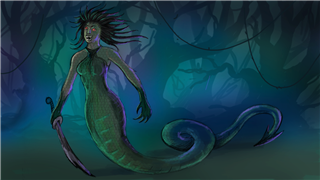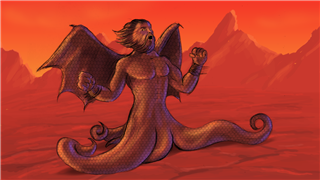
The ancient Greek pantheon is rife with symbolism. One such symbolic creature is Cerberus, the three-headed monstrous canine, the loyal servant and guardian of the Greek God of Death.
Did you know?
The first poisonous plants sprang up from the saliva of Cerberus and were used by the Thessalian witches to make a potion that enabled levitation.
The Greek pantheon is stuffed with all sorts of imaginary creatures – beasts and monsters alike. These are basically composite beings bearing bodies, heads, tails and wings of different animals at the same time which is why they seem to have characteristic traits of all the animals they are composed of. The idea behind the presentation of such creatures is to encompass all the good (or bad) qualities of the animals they are made of and thus to set before the people, an example of a perfect being. Cerberus is one such creature that occupied a prominent place in the mythology of the ancient Greeks.
Cerberus is the name of the three-headed hound of Hades, the Greek God of Death. In the Greek mythical tradition, Cerberus is the guardian of the gates of the underworld, the realm of Hades. His job is to prevent the living from entering the land of the dead and to prevent the dead from escaping the boundaries of the underworld. He is stationed on that bank of the Styx river which adjoins the underworld. Styx river, according to the Greek legends is a supposed boundary between the earth and the underworld. Its waters have miraculous powers that make a person bathing in it, immortal. Therefore, the river also needs to be guarded, a task with which Cerberus is also assigned.
The Creature: Etymology and Origin
The term ‘Cerberus’ is a latinized version of Greek ‘Kerberos’ which possibly refers to ‘devil of the pit’. The name, in some form, also resembles the name of one of Lord Yama’s (God of Death in Indian mythology) dog, ‘Sabala’, who is associated with the final judgment of the souls that enter his realm.
*Click images to enlarge.
Interestingly enough, the Homeric literature refers to a dog who guards Hades’ entrance but refers to him simply as ‘a dog’ and not ‘Cerberus, the three-headed dog’. Hesiod, in 7th – 8th century B.C., refers to the creature as being fifty-headed. He also states that he was a son of Typhon and Echidna. Typhon was a winged giant bearing a tail of a snake who could control and command the storms. He was the son of Gaia, mother earth of the Greek myths. Echidna, on the other hand, is a half-woman-half-serpent monster in the Greek tradition, who had supposedly mothered all the monsters appearing in the mythology. Some of the later sources describe Cerberus as having three canine heads, a dog’s body, a mane made of snakes and a dragon’s tail. This kind of composition makes the creature appear extremely monstrous and fierce. But this kind of representation fits perfectly owing to the kind of tasks that the creature is assigned with. Legend says that Cerberus was so dreadful to behold that anyone who tried to look at him with a bare eye, was turned instantly to stone.
As mentioned above, Cerberus is the hound of Hades with three heads. He is Hades’ most loyal companion and servant. Some classical sources state that these heads represent three phases of human life, viz. infancy, youth and old age. Another theory says that the three heads of the hell-hound symbolize the past, the present and the future. It has been mentioned that Cerberus fed on raw meat of the humans and so he ate all those mortals who dared to cross the Styx in order to enter the realm of Hades. In a way, Cerberus stands for the sharp line of distinction between the world of the mortals and the world of the dead. The myth of Cerberus attempts to highlight the fact that life and death are two distinct concepts which can never overlap with one another. If any such effort is made by any individual, he may have to face grievous consequences for the same. This also applies to the dead and their souls that reside in the underworld.
Cerberus in Greek Myths
Cerberus appears in numerous myths of the ancient Greeks, most of which put across a point that it was possible either to lull, subdue or capture the creature, as was proven by many at a number of times. However, one cannot ignore the deadly and fierce aspect of the creature due to which he was stationed where he was.

Credit: Wikimedia Commons
(PD)
♠ King Eurystheus had arrested and imprisoned Heracles for killing his own children after he was forced into a state of insanity by Hera, the wife of Zeus. In order to be released, he was assigned with a set of twelve labors that he had to perform according to the rules which were set. His twelfth and final labor was to capture Cerberus and to parade him openly in the Mycenaean capital and then to take the creature to the king. The only condition put forth by Eurystheus and Hades what that Heracles had to capture the creature unarmed which the demi-god managed to do. Cerberus was then paraded on the streets of the Mycenaean capital and then taken to the king as decided. But the king was so terrified on seeing the hell-hound that he asked Heracles to take it back to Hades with immediate effect.
♠ Persephone, the daughter of Demeter was abducted by Hades and was forcibly made to marry him. So, Demeter decided to enter the underworld in order to look for her daughter and take her back. But, as usual, she met Cerberus standing guard at the gates of Hades in light of which Demeter could never possibly enter his territory. So, it became necessary to get rid of Cerberus in order to proceed with her quest for Persephone. In an attempt to enter the underworld unnoticed, she threw some drugged sweet cakes before Cerberus which he ate and immediately fell unconscious. Demeter, then slipped past the beast.
There are some other tales as well that tell us that Cerberus could be subdued and lulled by playing melodious music to him. These legends show that Cerberus, no matter how formidable he seemed, could be hushed and captured, though with great efforts.
Literary Depictions
Cerberus appears numerous times in the popular literature, including prose and poetry alike. Apart from the classical Greek and Roman literary sources, we find references to Cerberus in medieval and modern writings as well.
♠ The first canto of Dante’s Divine Comedy is known as Inferno. It is an allegory speaking of Dante’s journey through Hell which is represented by nine circles of suffering located underneath the earth. Cerberus appears when Dante enters the third circle of Gluttony, where the creature is depicted as a watchdog guarding the Gluttons and making them undergo their share of sufferings. Gluttony stands for capitalization of all the food and wealth and depriving the needy of the same. It is considered as one of the deadliest sins and thus punishable even after death.
♠ Shakespeare’s Love’s Labor Lost refers to the twelfth labor of Hercules and says that Hercules was given a club by an imp with the help of which he succeeded in capturing and taming Cerberus, the three-headed canine that guarded Hades’ dominions.
♠ John Milton, in his poem Paradise Lost mentions ‘Cerberean’ hounds residing in the underworld. He says that the barks and cries of these hounds are deafening and unstoppable.
♠ Fever 103° is a poem by the renowned American poet Sylvia Plath which describes the misery of a woman having high fever and her wish to break the bonds of life and embrace death. Plath equates the misery with Hell and says that just as Cerberus, who guards the entrance to Hell cannot lick anything clean because the place where he resides is as it is very impure and unclean, even she cannot get rid of her pain and release herself from fever.
♠ Harry Potter and the Philosopher’s Stone (first part of the Harry Potter series) by J.K. Rowling has, as one of its characters, a three-headed dog called Fluffy. Fluffy is a huge hound that belongs to Rubeus Hagrid, the Gamekeeper and the Keeper of Keys and Grounds of Hogwarts School of Witchcraft and Wizardry, where Harry is a student. Fluffy is in charge of guarding the room wherein the philosopher’s stone is hidden. However, Hagrid tells Harry and his friends that Fuffy, however vicious he seemed, could be pacified and put to sleep by the sound of a flute, after which one could get into the room unnoticed. Fluffy resembles Cerberus in numerous respects.
Notably enough, Cerberus seems to be a popular subject of depiction amongst the authors and the public in general.
Artistic Expressions
In the classical art, Cerberus makes an appearance in almost everything that has to do with Hades or his realm. Thus, we have Cerberus depicted in statues, vase paintings and sarcophagi which are based on themes relating to Hades. The creature has been depicted as a ferocious canine either having a mane comprising serpents or a serpent tail. However, the number of heads is not always certain. Often he is portrayed as a three-headed dog, but there are instances where he has only two heads.

Credit: Sebastian Wallroth/
Wikimedia Commons (PD)
♠ On the pediment relief of Castle Friedrichsfelde, Berlin, the creature is depicted in the act of attacking. He has ferocious features, a mane, three heads, a snake’s tail, sharp teeth and violent eyes.
♠ A sculpture placed in Galleria Borghese, an art gallery in Rome, portrays a three-headed Cerberus sitting beside the standing image of Hades.
♠ A bronze in Naples that depicts the Eighth Labor of Heracles depicts Heracles driving the two-headed Cerberus out of Hell in order to parade him openly on the streets of the Mycenaean capital.
♠ The most modern depiction of Cerberus can be seen in a statue at the Berlin underground station, Rathaus Steglitz. This colossal piece of modern art depicts the creature with two heads facing two opposite directions.
Artistic depictions of the creature are many. Over a period of time, artists have tried to interpret the description of Cerberus in the classical sources in their own ways, thus giving us a large number of images portraying the creature in various styles.
Symbolism
Every being that forms part of the Greek mythology has a specified role to play in their legends and folklores. All the creatures are so deeply imbibed in their mythical tradition that if one attempts to remove them from the legends, a sort of vacuum would be formed and the continuity of the entire lore would get disrupted. Cerberus and the symbolism associated with him are also an inseparable component of the ancient Greek mythical tradition.
★ The three heads of Cerberus representing the three phases of human life are also indicative of the entry of death in the world of the living. It thus indicates that though death can enter the world of the living, life cannot enter the realms of death.
★ Cerberus symbolizes the balance between the worlds of the living and the dead which has to be maintained in order to ensure the smooth functioning of the universe.
★ Cerberus is a powerful creature that is extremely tough to capture or tame. However, at times it was possible for some to overpower him. This shows that though death is unavoidable and inexplicable at times, its fear can still be overcome by the sheer will power of a person.
★ The success of some of the mortals such as Heracles in taming the creature also points towards the fact that nothing is impossible in the world, no matter how Herculean the task seems.
★ Sometimes, Cerberus is considered symbolic of lawyers because of his three tongues that imply glibness.
★ Cerberus also symbolizes a being who is controlled by overwhelming desires and his three heads are sometimes seen as a symbol of evil intelligence or genius.
Some opine that Cerberus showed unmatched dedication towards the ancient Greek gods. Owing to this, Hades eventually released the creature which then took a human form and was called Naberius.
Creatures similar to Cerberus have also been found in other mythological traditions. In Egypt, a representation on Tutankhamun’s tomb portrays Anubis, guardian god of the tombs as a canine in a crouching posture. Anubis was a dog-headed god (contradictory viewpoints suggest Anubis to be a jackal-headed deity) who guided the souls of the deceased into the underworld. Similarly, in Norse mythology, a dog called Garm poses as the hell-hound. It is indeed interesting to note how myths travel from region to region and still manage to retain their inherent essence.




